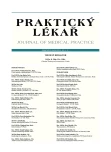Pohlová L., Kozáková R., Jarošová D.: Burn-out among nurses working in geriatric departments
Authors:
L. Pohlová; R. Kozáková; D. Jarošová
Authors‘ workplace:
Lékařská fakulta
; Děkan: doc. MUDr. Arnošt Martínek, CSc.
; Ostravská univerzita v Ostravě
Published in:
Prakt. Lék. 2011; 91(5): 274-277
Category:
Of different specialties
Overview
Aim:
The aim of this study was to determine the degree of burn-out in nurses working in departments that care for of seniors. This research attempted to reveal the relationship between the intensity of burn-out and between some factors such as
– age,
– sex,
– subjective feelings,
– education, and
– marital status of respondents.
Methods:
The group included 98 nurses from the Internal Clinic of the University Hospital in Ostrava, nurses from the Long-term care institution in Klokočov and from the Department of gerontopsychiatry of the Psychiatric Clinic in Opava. A standardized Maslach Burn-out Inventory (MBI) questionnaire was chosen for data collection, complete with identification data. Evaluation was made using Chi-quadrate test and Fisher exact test. Statistical tests were evaluated at a significance level α = 0,05.
Results:
Our study confirmed a statistically significant difference (p < 0.001) between nurses´ emotional exhaustion and their subjective feeling about their jobs. Burn-out was confirmed in 81 % of nurses who themselves had reported that they found their job very stressful. The research showed that age, family background, length of experience and level of education does not affect the incidence of burn-out in nurses.
Conclusion:
Burn-out impairs quality of life, affects quality of client care, leads to deteriorating relationships with colleagues and the social environment in general and also has significant economic implications. The basic prerequisite for preventing burn-out is primarily knowledge and awareness that burn-out exists.
Key words:
burn-out, nurses, geriatric departments, Maslach Burn-out Inventory.
Sources
1. Anderson, K. Grief experiences of CNAs: Relationships with burn-out and turnover. J. Gerontol. Nurs. 2008, 34(1), p. 42-49.
2. Bartošíková, I. O syndromu vyhoření pro zdravotní sestry. 1. vyd. Brno: NCONZO, 2006. s. 86. ISBN 80-7013-439-9.
3. Bužgová, R., Ivanová, K. Violation of ethical principles in institutional care for older people. Nurs. Ethics. February 1, 2011 18, p. 164-78.
4. Espeland, K. Overcoming burn-out: How to revitalize your career. J. Contin. Educ. Nurs. 2006, 37(4), p. 178-184.
5. Ewers, P., Bradshyw, T., McGovern, J., Ewers, B. Does training in psychosocial interventions reduce burn-out rates in forensic nurses? J. Adv. Nurs. 2002, 37(5), p. 470-476.
6. Gillespie, M., Melby, V. Burn-out among nursing staff in accident and emergency and acute medicine: A comparative study. J. Clin. Nurs. 2003, 12, p. 842-851.
7. Haškovcová, H. Péče o ošetřující týmy – pomáhající profese o sobě. Prakt. lék. 2000, 8, 4, s. 228-229.
8. Hosák, L., Hosáková, J., Čermáková, E. Syndrom profesionálního vyhoření zdravotnických zařízení. Psychiatr. prax, 2005, 6, 4, s. 202-203.
9. Jankovský, J. Etika pro pomáhající profese. 1. vyd. Praha: Triton, 2003. 223 s. ISBN 80-7254-329-6.
10. Jenkins, R., Elliot, P. Stressors, burn-out and social support: Nurses in acute mental health settings. J. Adv. Nurs. 2004, 48(6), p. 622-631.
11. Kalliath, T., Morris, R. Job satisfaction among nurses: A predictor of burn-out levels. J. Nurs. Adm. 2002, 32(12), p. 648-654.
12. Kebza, V., Šolcová, I. Syndrom vyhoření: Funkční duševní porucha. 1. vyd. Praha: SZÚ, 1998. 24 s. ISBN 80-7071-099-3.
13. Kennedy, B. Stress and burn-out of nursing staff working with geriatric clients in longterm care. J. Nurs. Scholarsh. 2005. 37(4), p. 381-382.
14. Kovářová, M., Ďorďovičová, S. Rizikové faktory profesionálneho vyhorenia európskych sestier. In Šramka, M. a Berešová, A. (ed.) Komplexná starostlivosť o človeka v hraničných situáciách. Prešov: Fakulta zdravotníctva a sociálnej práce bl. P. P. Gojdiča, 2006. s. 117-122. ISBN 80−969449−1−6.
15. Křivohlavý, J. Jak neztratit nadšení. 1. vyd. Praha: Grada Publishing, 1998. 136 s. ISBN 80-7169-551-3.
16. Libigerová, E. Syndrom profesionálního vyhoření. Prakt. Lék. 1999, 79, 4, s. 186-190.
17. Maslach, C. A multidimensional theory of burn-out. In C. Cooper (Ed.). Theories of organizational stress. Oxford: Oxford University Press, 1998.
18. Maslach, C., Jackson, S., Leiter, M. Maslach burn-out inventory manual (3rd Ed.). Mountain View, CA: Consulting Psychologists Press, 1996.
19. Miženková, L., Požonská, M., Kiliková, M. Komplexní přístup k syndromu vyhoření. MOLISA [online]. Leden 2009, roč. 1, [cit. 2010-04-06]. Dostupný z WWW: <http://www.unipo.sk/public/ media/10304/Mizenkova,%20Pozonska,%20Kilikova_syndrom%20vyhorenia%5B1%5D_1.pdf. >. ISBN 978-80-555-0048-5.
20. Oddie, S., Ousley, L. Assessing burn-out and occupational stressors in a medium secure service. Br. J. Forensic. Pract. 2007, 9(2), p. 1-12.
21. Patrick, K., Lavery, J. Burn-out in nursing. Aust. J. Adv. Nurs. 2007, 24(3), p. 43-48.
22. Sadowich, J. Work excitement in nursing: An examination of the relationship between work excitement and burn-out. Nurs. Econ. 2005, 23(2), p. 91-96.
23. Tošner, J., Tošnerová, T. Burn-out syndrom: Syndrom vyhoření: pracovní sešit pro účastníky kurzu [online]. [cit. 2010-04-06]. Praha: HESTIA, 2002. 16 s. Dostupné z: www: < http://www.pecujici.cz/prirucky.shtml?x=146980>ISSN: 1210-7840.
24. Venglářová, M. Problematické situace v péči o seniory: Příručka pro zdravotnické a sociální pracovníky. 1. vyd. Praha: Grada Publishing, 2007. 96 s. ISBN 978-80-247-2170-5.
Labels
General practitioner for children and adolescents General practitioner for adultsArticle was published in
General Practitioner

2011 Issue 5
Most read in this issue
- Chlumský J.: Differential diagnosis of elevated serum troponin in the department of Internal Medicine
- Pohlová L., Kozáková R., Jarošová D.: Burn-out among nurses working in geriatric departments
-
Biologická léčba v onkologii (II)
Monoklonální protilátky, cytokiny - Kučera I., Hlaváč P.: Evaluation of risk factors in the working environment and occupational diseases
